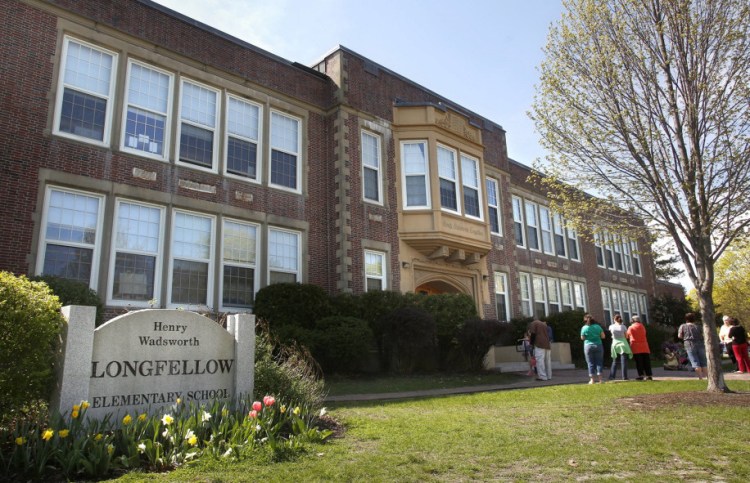It will cost $321 million over the next 20 years to keep all of Portland’s schools up to date and fully functional, according to a new draft capital plan for the district’s 17 schools and facilities.
The report provides new financial information to city and school leaders who are debating whether to put a $60 million to $70 million bond out to voters to renovate Reiche, Longfellow, Lyseth and Presumpscot elementary schools. The $70 million figure is in the new draft capital plan prepared by the Sebago Technics architectural firm.
The 247-page report, with includes details about repairs and upgrades recommended for each school, is posted online on the website for the School Facilities Ad Hoc Committee, which is considering the elementary schools renovation bond.
At a meeting Thursday, the ad hoc committee said it will hold a public hearing on the bond proposal Jan. 19. The committee has reached an informal consensus on a $61 million bond proposal that cuts costs by eliminating the second floors proposed for the Lyseth and Presumpscot schools, reducing the size of the gymnasiums and eliminating playground upgrades, among other cuts.
But Councilor Nick Mavodones said he’s been hearing from people who think the proposed bond is too high, and the committee members agreed to provide details on other scenarios for the public to comment on at the hearing.
“We owe it to the taxpayers to have some options,” Mavodones said.
Those include the full $70 million proposal, details on what the district could do with a $35 million bond, whether a smaller bond should cover only two schools instead of four, and what it would mean for the city if no bond was put out to voters. “I support getting every piece of information people need and making it very clear,” Mayor Ethan Strimling said of presenting multiple scenarios.
“But I think it’s pretty clear already. I think the public is aware of the cost and the sacrifice it will take and they are even more aware of what inaction means,” he said, adding that doing nothing would have “serious implications” for the city. “We know what those implications are because we have underfunded our schools for decades.”
SEEKING A BALANCE
The $61 million proposal, Strimling said, “is a pretty good balance weighing taxpayer concerns without damaging the educational integrity of what we are trying to accomplish here.”
Several members noted the soaring construction costs in the 20-year capital needs report, and said it put the elementary schools bond proposal in perspective.
“Truly, our needs are over $300 million. It’s very sobering, obviously. But in the context of looking at that, $70 million may not look so bad,” said school board member Sarah Thompson. “We’re not just trying to make our schools pretty. Really the need is exceeding what we can do. Seventy million (dollars) is a drop in the bucket.”
“The community deserves to know how much need there is,” she added. “We can only defer (maintenance) for so long. We’re millions in the hole because we kept deferring. As we do that, it’s getting worse.”
City Councilor Justin Costa said he was leaning toward supporting the $61 million proposal.
“The bottom line is we’ll have to do something of this magnitude,” Costa said.
School facility upgrades are typically made through the city’s long-term borrowing plan for major expenses, but a limited budget and competing needs citywide – such as fixing roads and sidewalks, or buying a fire truck – have left many projects without adequate funding. This year, spending on school facilities is only $950,000 of the $15.3 million Capital Improvement Plan budget.
This report was intended to get a comprehensive assessment of every building in the district and determine long-term needs. Items range from replacing roofs and doors to replacing heating systems. At Portland High School, for example, replacing lab benches would cost $1.6 million and upgrading interior lighting would run $2.5 million. Casco Bay and Portland Arts & Technology high schools, which share a building, need almost $200,000 in immediate fire protection work to replace sprinkler heads and $600,000 in security upgrades such as intrusion detection systems that include motion detectors.
Even new schools, such as Ocean Avenue Elementary School, will require $10.4 million over the next 20 years, according to the report. A vegetative roof system there will last only 15-20 years, and replacing it will cost about $230,000; replacing most of the heating and air conditioning system after a service life of 15-20 years will cost almost $5 million.
The school board has not yet discussed the report, which the board requested and authorized about two years ago.
PRELIMINARY FIGURES
Board Chairwoman Anna Trevorrow said it’s not clear how the capital needs report may affect the ad hoc committee’s discussion on the elementary school bond.
“We’re just starting to come down to what we want to recommend,” said Trevorrow, who sits on the committee. “I think there are members that are concerned about costs, and we may have to have further discussion. And there are still public hearings. Getting a sense of what the public wants is imperative at this point.”
The $321 million estimate is only for “hard costs,” or the actual construction work, and does not include “soft costs” such as engineering and design fees, permitting fees or utility connection costs. Those soft costs can add another 20 percent to 30 percent to the cost, the report said, which would boost the overall amount to at least $385 million.
The report emphasizes that these are “very preliminary” figures.
“Given the relatively volatile market, we cannot forecast the construction inflation for the coming years with any degree of certainty,” the report says. “We hope that these very preliminary construction costs help you understand an order of magnitude budget, and potential tax impacts as you consider options for phasing and implementation of your facility upgrades.”
Over the 20-year projection, the city’s nine elementary schools need $113 million, the three middle schools need $62 million and the three high schools need $130 million. The district office, Bayside Learning and central kitchen facilities need $10 million, according to the report.
Mavadones said he’s concerned about the projected cost of just a $60 million bond for the elementary schools. New figures released last Friday estimate it would raise taxes about $150 a year for the owner of a $225,000 home, with a total tax bill of about $2,500 over the life of the 20-year bond.
“The tax rates that are projected are unacceptable in my opinion,” he said. “We need to really have a frank discussion and figure out what the community can afford.”
The capital needs report breaks down the costs in five-year increments. According to the report, the district should make $152 million in investments in the next 10 years.
Send questions/comments to the editors.





Comments are no longer available on this story